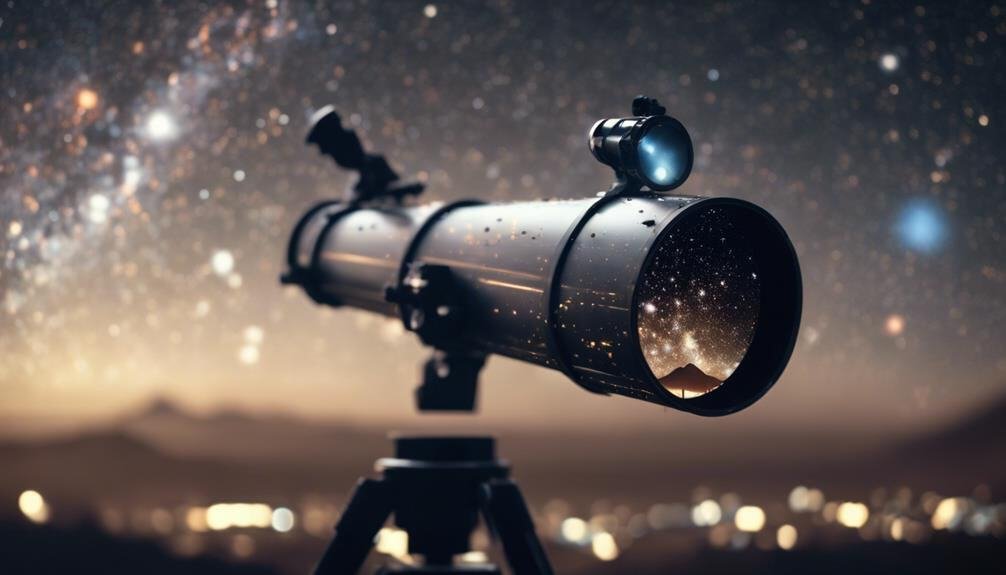AI in Astronomy: Exploring the Universe With Machine Intelligence
In the vast expanse of the cosmos, where the mysteries of the universe lie scattered across the night sky, a silent revolution is underway – the integration of artificial intelligence in astronomy.
As humanity strives to decipher the enigmas of the cosmos, AI emerges as a powerful ally, unlocking new realms of exploration and discovery. From unraveling intricate data patterns to unveiling distant exoplanets, the marriage of machine intelligence and astronomical pursuits promises a future where the boundaries of our understanding are continually pushed.
The implications of this fusion are profound and far-reaching, shaping the very fabric of how we perceive and interact with the universe.
Key Takeaways
- AI revolutionizes data analysis and interpretation in astronomy.
- Deep learning aids in image processing for astronomical data.
- Machine learning enhances exoplanet discovery and habitability analysis.
- Automated systems optimize telescope operation for efficient cosmic exploration.
The Role of AI in Astronomy
In the field of astronomy, artificial intelligence plays a pivotal role in data analysis and interpretation, revolutionizing the way researchers extract valuable insights from vast amounts of astronomical data. AI algorithms have enabled astronomers to make significant astronomical discoveries and unravel cosmic mysteries that were once beyond reach. By employing machine learning techniques, AI can sift through massive datasets more efficiently than traditional methods, identifying patterns, anomalies, and correlations that may lead to groundbreaking findings.
Astronomical discoveries facilitated by AI include the detection of exoplanets, classification of celestial objects, and identification of gravitational waves. These advancements have expanded our understanding of the universe and opened new avenues for exploration. Moreover, AI has been instrumental in solving complex astrophysical problems, such as mapping dark matter distribution and predicting celestial events with greater accuracy.
As researchers continue to harness the power of artificial intelligence in astronomy, the potential for further discoveries and insights into cosmic mysteries grows exponentially. The synergy between AI technology and astronomical research is driving innovation and propelling the field towards new frontiers of exploration.
Data Analysis and Pattern Recognition
Utilizing advanced machine learning algorithms, astronomers in the field of astronomy employ sophisticated data analysis techniques to extract intricate patterns and recognize key features within vast astronomical datasets. Deep learning plays a crucial role in analyzing complex data, especially in image processing tasks such as identifying celestial objects or mapping galaxies. Statistical modeling is used to understand the distribution of data points and make predictions about astronomical phenomena. Anomaly detection is another vital aspect, helping to identify rare events or outliers that could signify new discoveries or errors in the data.
| Data Analysis Techniques | Description |
|---|---|
| Deep Learning | Utilized for image processing and pattern recognition in astronomical images. |
| Statistical Modeling | Used to analyze and interpret the distribution of data points within astronomical datasets. |
| Anomaly Detection | Identifying unusual or rare occurrences in the data that may indicate new astronomical phenomena. |
| Key Feature Extraction | Techniques to extract important features from vast datasets to facilitate further analysis. |
Exoplanet Discovery and Characterization
The exploration of exoplanet discovery and characterization within the field of astronomy involves employing advanced technology and data analysis methods to identify and study planets outside our solar system. When it comes to studying exoplanets, one significant aspect is the analysis of exoplanet atmospheres. Machine learning algorithms are now being utilized to sift through vast amounts of spectroscopic data to identify key atmospheric components such as water vapor, methane, and carbon dioxide that provide insights into the exoplanet's composition and potential habitability.
Understanding exoplanet habitability is crucial in the search for potentially habitable worlds beyond our solar system. Deep learning techniques are now being applied to process complex data sets and model various environmental factors that influence a planet's suitability for life. By analyzing data on factors like temperature, atmospheric conditions, and the presence of key molecules, researchers can assess the habitability of exoplanets and prioritize further investigation into those with the highest potential for hosting life. This intersection of astronomy and artificial intelligence is revolutionizing our ability to discover and characterize exoplanets, bringing us closer to unraveling the mysteries of the universe.
Gravitational Wave Detection
Gravitational wave detection involves the precise measurement of ripples in spacetime caused by the acceleration of massive objects, providing valuable insights into cataclysmic events in the universe. Signal processing plays a crucial role in extracting meaningful information from the data received by gravitational wave detectors such as LIGO and Virgo. Machine learning algorithms are employed to enhance the sensitivity of these detectors, aiding in the identification of weak signals that may be indicative of distant and powerful cosmic events.
Event localization is another essential aspect of gravitational wave detection. By analyzing the signals detected by multiple observatories across the globe, scientists can triangulate the source of the gravitational waves with high accuracy. This process enables astronomers to pinpoint the exact location in the sky where the cataclysmic event occurred, facilitating follow-up observations using traditional telescopes.
Automated Telescope Operation
Employing automated systems, telescopes can operate continuously, efficiently conducting observations of celestial objects without the need for manual intervention. Telescope automation allows for remote observation and scheduling, enabling telescopes to be controlled from a centralized location without the need for on-site astronomers. This automation significantly increases the efficiency of observing programs, as telescopes can be scheduled to observe specific targets at optimal times automatically.
Automated telescope operation also plays a crucial role in optimizing observation time by swiftly reacting to changes in weather conditions. When adverse weather approaches, automated systems can quickly secure the telescope and resume operations once conditions improve, maximizing the utilization of clear skies. Moreover, automation reduces human errors and increases the overall productivity of telescopes by streamlining data collection processes and minimizing downtime between observations.
Enhancing Space Exploration Missions
How can advanced artificial intelligence systems contribute to the optimization and success of space exploration missions?
Artificial intelligence plays a crucial role in enhancing space exploration missions by enabling autonomous decision-making and improving efficiency.
Here are key ways AI enhances space exploration missions:
- Rover Navigation: AI systems can enhance rover navigation by analyzing terrain data in real-time and making autonomous decisions on the best routes to take.
- Autonomous Decision Making: AI allows spacecraft to make decisions independently based on predefined objectives and data inputs, reducing the need for constant human intervention.
- Satellite Communication: AI can optimize satellite communication by predicting signal disruptions, adjusting transmission parameters, and enhancing overall data transfer efficiency.
- Deep Learning Algorithms: By utilizing deep learning algorithms, AI can analyze vast amounts of space data to identify patterns, anomalies, and scientific insights that might be challenging for human operators to detect.
- Mission Planning: AI systems can assist in mission planning by optimizing resource allocation, scheduling tasks, and predicting potential obstacles to mission success.
Future Prospects and Innovations
The future prospects and innovations in AI applications for astronomy are centered around cutting-edge technologies that enable more efficient data analysis.
Revolutionary advancements in machine learning algorithms have the potential to revolutionize how vast amounts of astronomical data are processed.
These innovations in technology are paving the way for new discoveries and insights into the universe.
Cutting-Edge AI Applications
Advancements in artificial intelligence technology are revolutionizing the field of astronomy by pushing the boundaries of what is possible in analyzing vast amounts of astronomical data. In the realm of cutting-edge AI applications in astronomy, some key innovations include:
- Deep Learning Algorithms: Utilizing advanced neural networks for tasks like image classification.
- AI-Driven Telescopes: Telescopes equipped with AI technology for autonomous operations and data optimization.
- Data Optimization: AI algorithms are enhancing data processing to extract meaningful insights efficiently.
- Automated Object Detection: AI systems can automatically identify celestial objects in vast datasets.
- Predictive Modeling: AI is used to forecast astronomical events and phenomena based on historical data and patterns.
Revolutionary Data Analysis
Artificial intelligence's integration into astronomy is poised to revolutionize data analysis with upcoming advancements focusing on cutting-edge techniques and innovative methodologies for extracting deeper insights from vast astronomical datasets. Innovations in data analysis within astronomy are driven by the development of innovative algorithms and the application of deep learning techniques. These advancements enable the processing of massive amounts of data more efficiently and accurately than ever before. By utilizing sophisticated algorithms and implementing deep learning models, astronomers can uncover hidden patterns, classify celestial objects, and make predictions with higher precision. The fusion of AI and astronomy holds immense potential for enhancing our understanding of the universe and unraveling its mysteries.
| Innovative Algorithms | Deep Learning Techniques |
|---|---|
| Bayesian Inference | Convolutional Neural Networks |
| Random Forests | Recurrent Neural Networks |
| Support Vector Machines | Generative Adversarial Networks |
| K-means Clustering | Transfer Learning |
| Gaussian Processes | Autoencoders |
Advancements in Technology
Harnessing cutting-edge technological developments propels the integration of artificial intelligence into astronomy, paving the way for unprecedented advancements in data analysis and scientific discovery. The field of astronomy is witnessing rapid progress due to the implementation of machine learning and deep learning techniques. Innovations in technology are revolutionizing how astronomers process vast amounts of data and extract meaningful insights from complex datasets. Some key advancements include:
- Utilizing neural networks for image recognition tasks.
- Implementing deep learning algorithms to classify celestial objects more accurately.
- Developing sophisticated data mining tools to discover patterns in astronomical data.
- Creating automated systems for real-time monitoring of celestial events.
- Enhancing simulations of astrophysical phenomena using machine learning models.
Conclusion
In conclusion, the integration of AI in astronomy has revolutionized the way we explore the universe, from data analysis to exoplanet discovery.
With advancements in machine intelligence, we have unlocked new possibilities in understanding celestial phenomena and enhancing space exploration missions.
The future holds great promise for further innovations and discoveries in the field of astronomy, as we continue to harness the power of artificial intelligence to unravel the mysteries of the cosmos.







